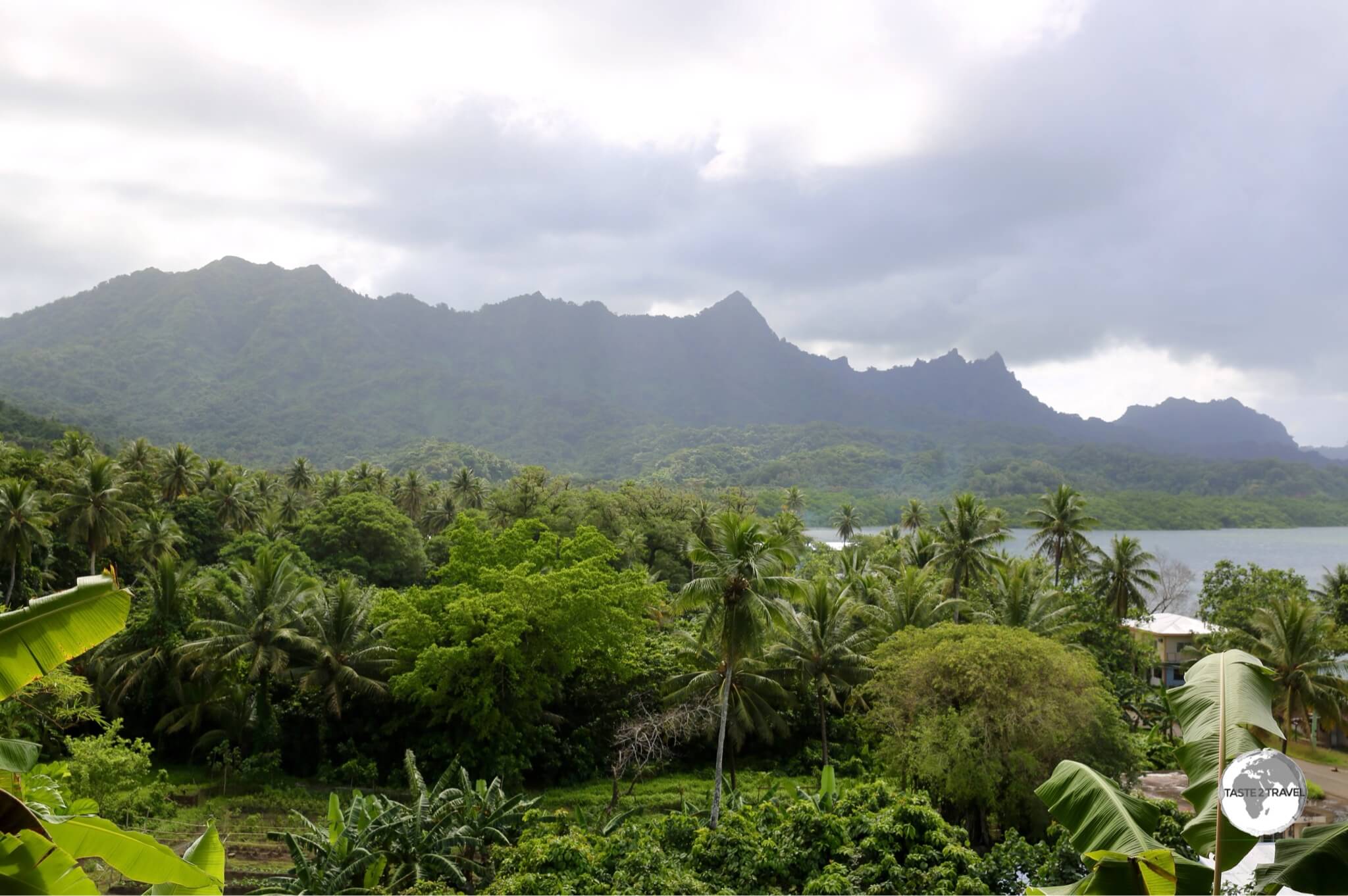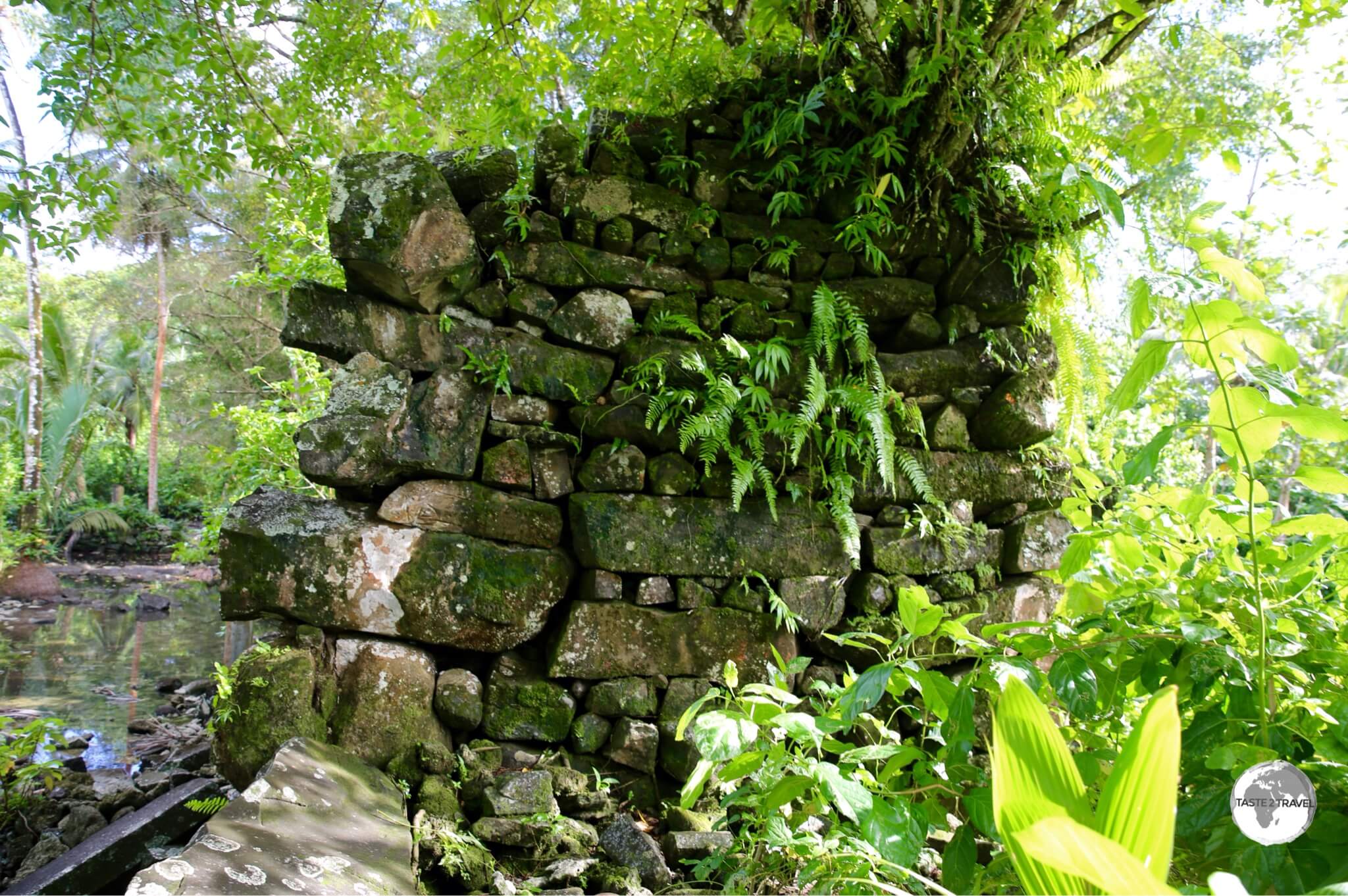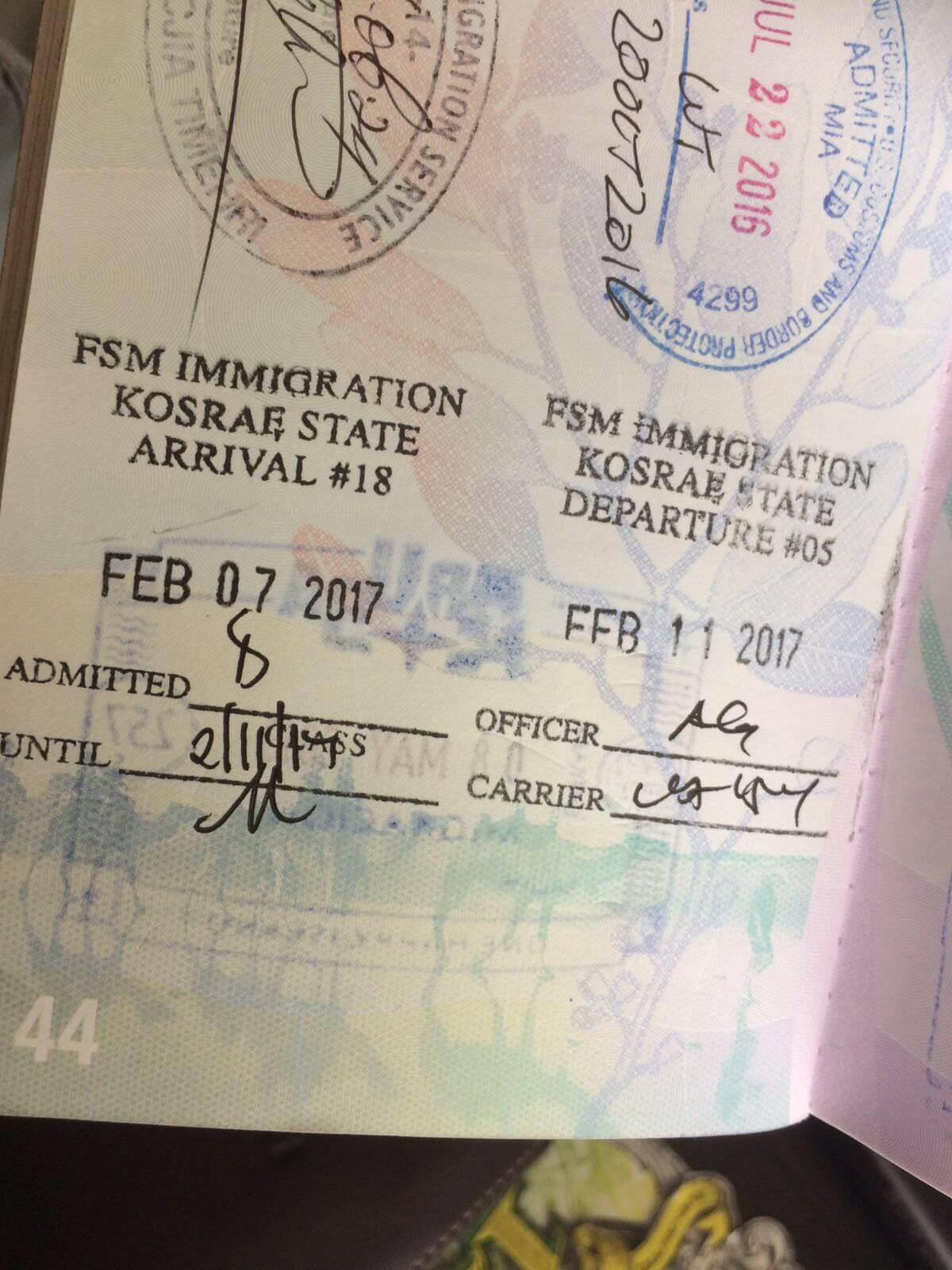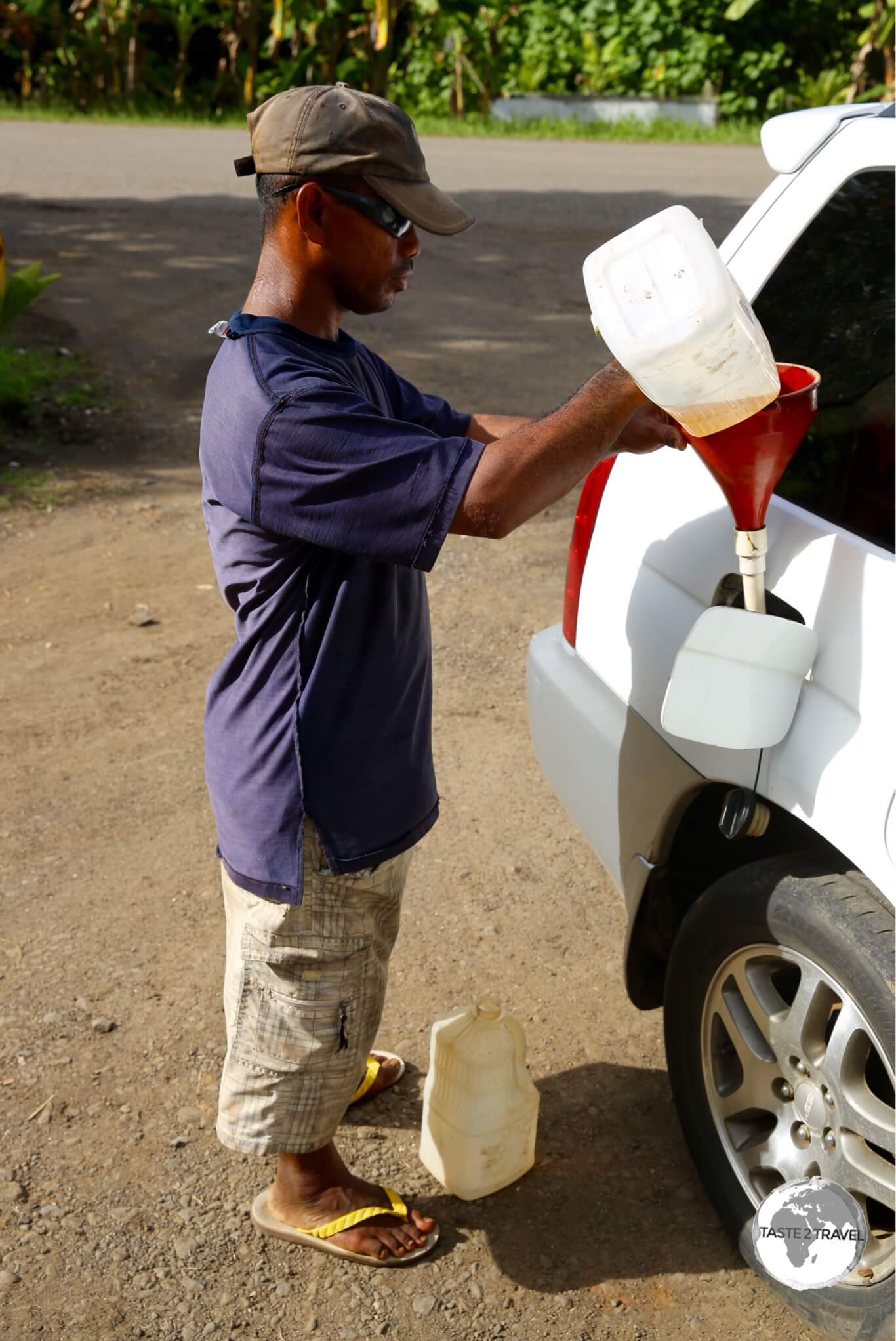Kosrae Travel Guide
Welcome to the taste2travel Kosrae Travel Guide!
Date Visited: February 2017
Introduction
Looking out the window from my usual seat (32D) on the United Airlines Island Hopper, I saw a spectacular sight rising up out of the cobalt blue depths of the Pacific – a magnificent emerald-coloured, volcanic pinnacle.
This must be Kosrae (pronounced “Kosh-rye“), the island of the sleeping lady – the most easterly state in the Federated States of Micronesia.

The profile of the main mountain range, which is said to resemble a ‘sleeping lady’.
Remote, raw, spectacular – a lush, green, veritable ‘paradise lost‘. There is no doubting from the moment you set foot on the tarmac at Kosrae International Airport that you have arrived somewhere special.
Despite being a nearly full flight only half a dozen passengers disembarked at Kosrae. Clearing immigration and customs took just a few minutes. Outside the airport, there was an air of relaxed calm with a few people waiting around to collect arriving family members.
There was also the representative from my hotel – the Pacific Treelodge Resort, one of just two hotels on the island. It was clear I was the only tourist arriving today.
I was later told that the island receives around 300 visitors per year. As is custom when someone arrives on Kosrae, the friendly hotel representative placed a flowery lei on my head. We then set off on a very leisurely drive to the hotel, which was located on the other side of the island.

All visitors to Kosrae receive a flowery lei at the airport.
The first thing you notice on Kosrae is how quiet it is. With a total population of 6,600 inhabitants, the whole island is one big village with very little traffic. The speed limit is set at 25 mph (40 km/h) but locals tend to drive much slower. It’s life in slow motion. And why not? Where are you rushing to?
The only paved road runs along part of the coast, from the airport in the north-west, over the top of the island, down the east coast, through the tiny state capital of Tofol, to the southern town of Utwe. It’s a leisurely one hour drive.

A curious local boy on Kosrae.
There is something magical about tiny Kosrae, a magic that comes from the remote, spectacular beauty of the island – a remoteness that ensures you will have the island almost to yourself.
The ‘magic’ comes from the relaxed, slow pace of life, the warmth and gentle nature of the friendly locals. There is an innocence to life on Kosrae which has long been lost in most other parts of the world.
After five days on Kosrae, the island had worked it’s magic on me and if you ever have the chance to visit you too will no doubt experience the magic that is Kosrae.
Whatever you do – don’t rush your stay here!
Location
Located in the central Pacific region, 600 km north of the equator, Kosrae is the most easterly of the four states which comprise the Federated States of Micronesia.
Federated States of Micronesia
Kosrae’s land area is 110 square kilometres sustaining 6,600 people. The population has been declining steadily over the years as more people move elsewhere to find work – especially the USA where Micronesians have the right to live and work. Tofol is the state capital. Mt. Finkol is the highest point at 634 metres.
History
Kosrae hasn’t always been so quiet. The ruined city of Lelu was established around 1250 AD, reaching it’s heyday during the 14th and 15th centuries with a population of 1,500 and covered some 27 hectares. The rulers of Lelu conquered and unified the whole of Kosrae. They ran the island under a hierarchical monarchy system similar to Tonga.
The first Europeans to make contact with the island were the Spanish in 1529 who were sailing from Indonesia to their colony of New Spain in present day Central America. At the time the population of Kosrae was estimated at 6,000 persons. The Spanish took nominal control of the island and since that time the island has passed from Spanish control to German to Japanese to US.
Following the end of WWII in 1945 and the defeat of the occupying Japanese, administration over Kosrae passed to the United States, which ruled the island as part of the Trust Territory of the Pacific Islands.
In 1979 Kosrae joined with the states of Pohnpei, Chuuk and Yap to form a constitutional government, becoming a sovereign state (Federated States of Micronesia) after independence was attained on November 3, 1986 under a Compact of Free Association with the United States.
Flag

The flag of Micronesia.
The flag of the Federated States of Micronesia (FSM) was adopted on 30 November 1978. The blue field represents the Pacific Ocean, while the four stars represent the states in the federation: Chuuk, Pohnpei, Kosrae and Yap.
Currency

The US Dollar.
In centuries past, the islands of FSM, notably Yap, used stone currency, which was referred to as “Rai” or “Fei”. Impossibly large and too heavy to carry, this traditional currency, which seemed to be more suited to a giant, was crafted from Calcite, which was carved into doughnut-shaped disks.

Yap Stone Currency.
Source: https://medium.com/the-mission/the-island-of-yap-and-the-idea-of-money-9f570421d854
Today, along with all former members of the Trust Territory of the Pacific Islands, the official currency of FSM is the US dollar which is so much easier to carry.
Sights

The mangrove walkway at Senny’s Treelodge Hotel.
The best way to get to know the island is to first book a tour with the local fauna and flora expert – Carlos. I organised the tour through Maria at the Island Hopper Resort.
Carlos is a native of Puerto Rico who came to Kosrae many years ago as a Peace Corps volunteer.
He fell in love with the island and its people and has stayed ever since. Carlos’ enthusiasm for Kosrae’s natural attractions is infectious, and it won’t take long before he has roped you into helping him find the elusive small blue-faced parrot finch (after a day spent searching, I still never spotted one).

Curious green lizard.
Wiya Bird Cave

Inside Wiya Bird Cave.
The first stop on our tour was the Wiya Bird Cave, located in Tafunsak (about three miles from the airport).

Swiftlets at the entrance of Wiya Bird cave.
The mouth of the cave has a large opening that goes back about 20 metres and is home to thousands of Island Swiftlet birds who have built their nests on the roof of the cave.

Swiftlet nests on the ceiling of Wiya Bird cave.
There ceiling is covered in nests and, while these are out of reach, others can be easily found littering the floor of the cave, having become dislodged.
As is the custom in Micronesia, there is an entrance fee payable to the family ($2) whom own the land where the cave is located. You must pay before you enter – their house is along the road from the cave entrance.

A fallen Swiftlet nest collected from the cave floor.
After the cave Carlos took me down some back roads in search of local wildlife and bird life.
Carlos drives a little red Hyundai and it doesn’t take long to realise that this small car seems to possess 4WD capabilities.
Carlos loves bouncing along muddy, dirt tracks, pointing out majestic examples of the soaring native almond tree (used to build the long canoes unique to Kosrae) and other amazing plant life.

Touring the forested interior of Kosrae with Carlos.
After showing me some towering Almond trees, Carlos took me to a place where I could see two of the famed Kosrae canoes.
Kosrae canoes are renown in Micronesia as they are much longer than those on other islands since the trees on other islands do not grow as tall and as straight as the Almond tree.

Kosrae canoes are renown for their length as they are constructed from the trunk of the native Almond tree.
After he had driven me the length of the island, I invited Carlos to join me for a late lunch at the restaurant at Kosrae Nautilus Resort (see ‘Eating out’ below for more details), where his wife is one of the cooks. He convinced me to order the deluxe burger, which she prepared. It was amazing.
Lelu Ruins
After lunch, Carlos drop me at the nearby Lelu ruins, the main historical and archaeological site on Kosrae. Similar to Nan Madol on neighbouring Pohnpei, Lelu was once a thriving city. The city is built of blocks of coral and basalt. It consists of housing, royal tombs and sacred spaces. Today it’s completely overgrown and visiting it requires you to have a little bit of an Indiana Jones spirit – at least there are no snakes on the island.

The very over-grown Lelu ruins, Kosrae’s version of Nan Madol.
Once you find your way into the complex you will find sections of the old stone walls which are still visible but most of the complex has been reclaimed by nature.
Lelu reached its zenith during the 14th and 15th centuries, with elements still visible at the time of European contact in the early 19th century. The rulers of Lelu gradually conquered and thus unified the island of Kosrae. From their capital, they ruled Kosrae with a monarchy that archaeologists believe was similar to the kingdoms of Tonga and Hawaii.

Since its decline, materials from Lelu have been recycled for other uses throughout Kosrae.
Diving
If you’re interested in diving while on the island I would recommend contacting (and diving with) Mark at the Island Hopper Resort.
Mark has been diving on the island for years and is a PADI Dive Instructor who runs the dive shop out of the Island Hopper Resort, of which he is the owner, along with wife Maria.
Mark took me on two dives at Hiroshi’s Point on the south side of the island. Because of the topography of the island (i.e. underwater drop-offs), dives on Kosrae tend to be drift dives along walls.
Everything, from the equipment, to Mark’s guidance and expertise, and the fresh tuna steak sandwich for lunch (prepared by the chef at Bully’s) was fantastic.
It was a great day of diving and, due to the low visitor count on the island, we had the reef to ourselves.
There is also a dive operation at the Kosrae Nautilus Resort with a resident Dive Master.
Green Banana Paper Company
Once I had finished my dives I treated myself to a screen printed “Dive Kosrae” t-shirt from the Green Banana Paper Company.

My “Dive Kosrae” t-shirt, which was screen-printed by the Green Banana Paper Company.
During my meander around the island with Carlos, we stopped by the Green Banana Paper Company. This fascinating enterprise was created by Matt Simpson, a young American who originally came to Kosrae as a teaching volunteer. In between teaching and surfing, Matt developed a vision – “to create a company that could help the local community by creating jobs and sustainable products from renewable materials”.
The following images describe the paper making process:

Step 1. Banana plants arrive at the factory for processing – a sustainable use of old banana trees.
Matt certainly has realised his dream and today, the factory produces quality recycled paper which is made using old banana plants (they are plants and not trees).

Step 2. Once unloaded, the banana plants are taken for shredding.
Today, the company produces paper from various local plant fibre (banana, taro and pineapple) and recycled paper. This paper is then turned into an array of beautiful items by the company artisans.

Step 3: The shredded plants are laid out to dry.

Step 4: The dried plant fibre is pulped with recycled paper and laid out to dry on wooden frames.

Step 5: Once dried, the company artisans transform the paper sheets into wallets, stationary, cards etc.

Step 6. The final product, ready for sale at https://greenbananapaper.com/
Matt has also installed screen-printing equipment and has used his graphic-design skills to design his own range of ‘uniquely Kosrae’ t-shirts. The shirt designs are beautifully unique – a great souvenir of Kosrae.
The factory is located on the main road in the village of Finaunpes and is open for free tours during weekdays. There is an onsite gift shop where you can purchase the beautiful handmade products. The following images provide an overview of the paper making process:
The making of a ‘Dive Kosrae’ t-shirt:

The screen printers’ colour palette.

The screen featuring the ‘Dive Kosrae’ design.
`

Screen printing the design onto the t-shirt.

The applied design on the back of the t-shirt.

The final step – ‘curing’ the design.
Accommodation
There are just three accommodation options on Kosrae which is more than enough to accommodate the trickle of visitors who make it to this remote outpost.
Island Hopper Hotel

The most recent addition to the accommodation scene on Kosrae, the Island Hopper Hotel is owned by Maria and Mark, who were the former owners of the Pacific Tree Lodge Resort (now rebranded as Senny’s Treelodge Hotel).
While I have not stayed at the hotel a recent traveller reported that the rooms are superb and spotlessly clean.
Rooms cost from US$119/night and can be booked by contacting Maria at info@islandhopperhotel.com
They also rent out Toyota Harriers for US$63/day.
The hotel includes a free shuttle service to and from the airport.
Senny’s Treelodge Hotel

The sprawling mangrove swamp at Senny’s Treelodge Hotel.
I chose to stay at Senny’s Treelodge Hotel which, during my visit, was known as the Pacific Tree Lodge Resort.
The resort was owned and operated by wife and husband team – Maria (Italian) and Mark (American) who now operate the Island Hopper Hotel.
Located on the main road on the north-east coast, facing the ocean and surrounded by a mangrove swamp, the resort offers spacious rooms laid out around the edge of the mangrove.
It is also home to the #1 restaurant/ bar on Kosrae – Bully’s Bar – (see the ‘Eating out‘ below for more details). Bully’s is also used as a venue for other activities. On the day I arrived, Maria invited me to join the weekly yoga class on the deck of Bully’s overlooking the mangrove. There is a movie night held once a week at Bully’s – complete with popcorn. Basically everything you need is in one place.
The warm, friendly staff at the resort ensure your stay is a memorable one.
In between keeping the place spotlessly clean, they use the flowers from the garden to prepare floral lei’s for arriving guests, flower arrangements for the rooms and when in the mood will strum the ukulele in Bully’s and sing enchanting local folk songs.
It all forms part of the magic of the island.
Kosrae Nautilus Resort

Joshua, by the pool at his ‘raffle-ticket-winning’ property – Kosrae Nautilus Resort.
Kosrae Nautilus Resort made worldwide headlines in 2016 when the original Australian owners, who had spent 20 years building up the business, decided to raffle the resort instead of selling it to a rich developer. This created a worldwide frenzy which resulted in the sale of 75,485 tickets at US$49 per ticket in 150 countries.
The lucky winner was Joshua, a 27 year old accountant from Wollongong, Australia.
On the evening the owners called Joshua to inform him that he had won a multi-million dollar, 18 room resort, he was at the pub having drinks with some friends. He thought his mates were on the phone playing a joke on him.
Little did he realise that at that moment his life was about to change in a monumental way.
Joshua had just been handed the keys to a resort which is free of debt, profitable and has more than 20 years remaining on its lease. Joshua first had to look on a map to check where in the world Kosrae was located, then hopped on a plane and the rest is history.
KNR offers an air-conditioned restaurant (important in this part of the world) and the only swimming pool on Kosrae. Surrounding the pool are lush tropical gardens, a vegetable garden (used to supply the restaurant) and eighteen fresh, modern rooms. For those interested in diving, KNR has a dive operation, Nautilus Divers, staffed by a resident Dive Master.
Both hotels can be booked on booking.com
Eating Out
When it comes to produce, Kosrae is blessed in many ways. Because of the rich volcanic soil, the whole island is one big fertile garden. Everywhere you look, you’ll see fruit trees, vegetable gardens and so much more.

A freshly picked Kosrae Tangerine.
The ocean waters surrounding the island provide an abundant supply of fish and as such, are favoured fishing grounds for countries such as Japan, Taiwan, Korea and the US. Tuna is king here but you will also find lobster everywhere on the menu. Whilst I was on the island, I enjoyed the freshest of sushi and sashimi at least once a day.

The awesome ‘Sushi Deluxe’ special at Bully’s – incredible value!
There are just two restaurants on Kosrae, one at the Kosrae Nautilus Resort and one at the Pacific Treelodge Resort. The most popular of the two is Bully’s Bar. This restaurant/ bar is named after Bully Hayes, a notorious American-born ship’s captain who was variously described as a pirate, cheap swindler, bully, con man, thief and bigamist. Bully Hayes operated in the Pacific in the mid 19th century and always evaded capture. However he was eventually killed by his cook off the coast of Kosrae in 1877.

The tranquil view of the mangrove from the deck of Bully’s restaurant.
Located on the edge of a lush, green mangrove, Bully’s is adjacent to Senny’s Treelodge Hotel.
The head chef at Bully’s is a local man who worked for many years in a Japanese restaurant in Waikiki. He returned to Kosrae armed with a whole lot of talent and ideas.
His creations are amazing (especially his freshly prepared ‘sushi deluxe’ platter) and the portions very generous. You can be sure that the sushi/ sashimi at Bully’s is prepared using fresh, local tuna, which is something everyone should get to tantalise their taste buds with at least once in their lifetime.

Pathway through the mangrove to Bully’s Bar.
The restaurant can be reached along an elevated pathway, which takes you through the mangrove swamp. The pathway is constructed from concrete slabs, which contain colourful shards of locally recycled glass – another recycling project from Mark and Maria.
Located at the front of Kosrae Nautilus Resort, and facing the ocean, is the one other dining option on Kosrae.
Food here is also very good and since there are just two choices on the island there is a good chance you’ll end up eating here at some stage. At KNR, you have the choice of dining in air-conditioned comfort inside the restaurant or outside by the swimming pool. As with Bully’s, you will dine on the freshest of local seafood. The resort has its own vegetable garden to supply the restaurant with the freshest produce possible.
Visa Requirements

Kosrae Passport Stamps.
Some nationalities require visas for the Federated States of Micronesia – check your visa requirements prior to arrival.
Getting There
By Air

Kosrae International Airport.
Flights to Kosrae arrive at Kosrae International Airport, which is dramatically located on a slice of reclaimed land across a channel from the main island.
The airport is connected to the mainland by an ornate, balustraded, white-marble bridge which was a ‘gift’ of the government of China since the government of the FSM chooses to do business with China, rather than Taiwan.

The United Airlines ‘Island Hopper’ – UA154 – at Kosrae International Airport.
United Airlines’ Island Hopper
There is only one way to reach Kosrae and that’s aboard United Airlines famous ‘Island Hopper‘ – flight UA154.
The Island Hopper essentially performs a huge milk run across the central pacific, connecting Hawaii with the Marshall Islands, Kosrae, Pohnpei, Chuuk then finally Guam – a journey of 6,117 kilometres (3801 miles) stopping at some of the remotest islands on planet earth.

The ‘Island Hopper’ departure board at Kosrae airport.
It’s an essential service, but also a monopoly operation, so tickets are not cheap. United Airlines are part of the Star Alliance network. If you’re a member of a Star Alliance program, using points instead of paying cash can be a lot more reasonable.
For complete coverage of UA154, from Hawaii to Guam, please refer to my Central Pacific Island Hopping report.

Departing Kosrae on United Airlines “Island Hopper” UA154.
Getting Around
Bus
There are no buses on Kosrae.
Taxi
There are three small taxi companies operating on the island.
Car
Cars can be rented through either of the two hotels or through agents in Tofol. I rented a car through Pacific Tree Lodge Resort at $30 per day. One day is sufficient to explore the entire island.

The license plate of my rental car on Kosrae.
One quirk on the island is that cars are never refuelled directly from a petrol pump, but rather from one gallon containers, which have been filled from the pumped. It was explained to me that locals don’t trust what they can’t see so they will not use a pump.

Refuelling ‘Kosrae style’.
That’s the end of my Kosrae Travel Guide.
Safe Travels!
Darren
Follow me on Instagram:
Further Reading
- Other travel reports from the Pacific region:
Kosrae Travel Guide Kosrae Travel Guide Kosrae Travel Guide Kosrae Travel Guide Kosrae Travel Guide Kosrae Travel Guide Kosrae Travel Guide Kosrae Travel Guide Kosrae Travel Guide Kosrae Travel Guide
Author: Darren McLean
Darren McLean is an Australian, full-time, digital nomad who has spent 37 years on a slow meander around the globe, visiting all seven continents, 189/ 193 UN countries and 240/ 251 UN+ countries and territories.
He founded taste2travel to pique one’s curiosity and inspire wanderlust.





